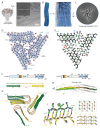Cryo-EM structure of a neuronal functional amyloid implicated in memory persistence in Drosophila
- PMID: 32165583
- PMCID: PMC7182444
- DOI: 10.1126/science.aba3526
Cryo-EM structure of a neuronal functional amyloid implicated in memory persistence in Drosophila
Abstract
How long-lived memories withstand molecular turnover is a fundamental question. Aggregates of a prion-like RNA-binding protein, cytoplasmic polyadenylation element-binding (CPEB) protein, is a putative substrate of long-lasting memories. We isolated aggregated Drosophila CPEB, Orb2, from adult heads and determined its activity and atomic structure, at 2.6-angstrom resolution, using cryo-electron microscopy. Orb2 formed ~75-nanometer-long threefold-symmetric amyloid filaments. Filament formation transformed Orb2 from a translation repressor to an activator and "seed" for further translationally active aggregation. The 31-amino acid protofilament core adopted a cross-β unit with a single hydrophilic hairpin stabilized through interdigitated glutamine packing. Unlike the hydrophobic core of pathogenic amyloids, the hydrophilic core of Orb2 filaments suggests how some neuronal amyloids could be a stable yet regulatable substrate of memory.
Copyright © 2020 The Authors, some rights reserved; exclusive licensee American Association for the Advancement of Science. No claim to original U.S. Government Works.
Conflict of interest statement
Figures




Comment in
-
Spot the Difference: Function versus Toxicity in Amyloid Fibrils.Trends Biochem Sci. 2020 Aug;45(8):635-636. doi: 10.1016/j.tibs.2020.04.007. Epub 2020 May 3. Trends Biochem Sci. 2020. PMID: 32376150 Free PMC article.
References
-
- Lynch G, Baudry M. The biochemistry of memory: a new and specific hypothesis. Science. 1984;224:1057–1063. - PubMed
-
- Crick F. Memory and molecular turnover. Nature. 1984;312:101. - PubMed
-
- Shorter J, Lindquist S. Prions as adaptive conduits of memory and inheritance. Nat Rev Genet. 2005;6:435–450. - PubMed
-
- Fioriti L, et al. The Persistence of Hippocampal-Based Memory Requires Protein Synthesis Mediated by the Prion-like Protein CPEB3. Neuron. 2015;86:1433–1448. - PubMed
Publication types
MeSH terms
Substances
Grants and funding
LinkOut - more resources
Full Text Sources
Other Literature Sources
Molecular Biology Databases

